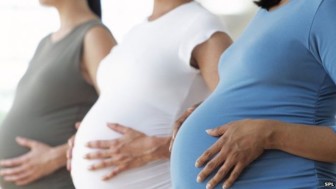About 650 U.S. women die each year during pregnancy, childbirth, or shortly after giving birth, according to the Centers for Disease Control and Prevention.
![]() Compared to other countries – and not just newly developing ones – that figure is abysmal. In fact, according to a new study from the World Health Organization and others, the U.S. is one of just 13 countries where the maternal mortality rate has actually risen between 1990 and 2013. Other countries on that list include North Korea and Zimbabwe.
Compared to other countries – and not just newly developing ones – that figure is abysmal. In fact, according to a new study from the World Health Organization and others, the U.S. is one of just 13 countries where the maternal mortality rate has actually risen between 1990 and 2013. Other countries on that list include North Korea and Zimbabwe.
The gross domestic product of Zimbabwe is $13.5 billion. The gross domestic product of North Korea is a little less than that, $12.38 billion (probably, though we know so little about North Korea).
The World Bank says our gross domestic product is nearly $16.8 trillion, yet pregnant women and new mothers in China and Saudi Arabia fare better than here in the U.S. Since 1990, the United States’ rate went from 12 deaths per 100,000 to 18. (By comparison, during the same time period, Canada’s average stayed at roughly 6 per 100,000.)
That, as said in the Washington Post Wonkblog, is a national embarrassment. Scientists are perfecting nanobots that will soon act like white blood cells, and we can’t shepherd women through this most natural of events?
And lest you think Connecticut is above it all, the Department of Health says the state’s maternal mortality rate was 7.3 per 100,000 births between 2011 to 2013.

The maternal mortality rate has risen in the U.S. between 1990 and 2013.
According to the Centers for Disease Control and Prevention, in 2011 the maternal mortality rate for white women was 12.5 deaths per 100,000 live births, compared to 42.8 deaths per 100,000 live births for black women, and 17.3 deaths per 100,000 live births for women of other races. This is one of the biggest disparities found in public health, according to the federal Department of Health & Human Services.
Why are the numbers so high?
No one’s entirely sure, though organizations that study the data say lack of access to prenatal health care plays a role. The Affordable Care Act may have contributed to the overall health of the nation — recent reports said Obamacare has contributed to a steep rise in early-stage cervical cancer detection among young women, for one – but it has yet to make a dent in this awful statistic.
Amnesty International says that worldwide, a woman dies every minute and a half during pregnancy or childbirth. The United Nations’ Millennium Development Goals, set this year, 2015, as the deadline for reducing maternal mortality by three-quarters worldwide. The rate has been cut by nearly 44 percent, but that’s far short of the goal.
Meanwhile, some research suggests the maternal mortality rate increase may be the result of a revised death certificate that includes a question about whether the deceased was pregnant. Connecticut’s death certificates contain such a check box, and this makes data collecting more targeted and accurate. In fact, research from 10 years ago found that maternal mortality rates were vastly underreported. A study five years later found that adding check boxes on death certificates increased the number of known maternal deaths.
But there’s no denying racial and class health disparities, and until policies specifically address those issues – better overall health for women of color and women in poverty, better access to prenatal and post-natal care — the U.S. can expect to scrape along the bottom with North Korea and other countries we should loathe to emulate.
Susan Campbell is a distinguished lecturer at the University of New Haven and the Robert C. Vance Chair for Journalism and Mass Communication at Central Connecticut State University. She can be reached at slcampbell417@gmail.com.